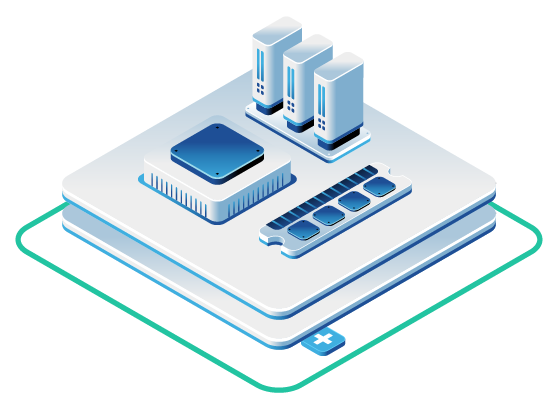
In the ever-evolving cloud landscape, organizations face a pivotal choice in how to handle growing workloads: scale up (add more resources to a single server or VM) or scale out (add more servers or instances to share the load). This is the classic vertical vs. horizontal scaling debate.
Enter MicroVMs – a new breed of lightweight virtual machines – which are tipping the scales in favor of scaling out. MicroVM technology has gained traction for powering serverless platforms, handling surges of API traffic, and distributing AI inference jobs.
This in-depth article explores what MicroVMs are, why they excel at horizontal scaling (and are less suited to vertical scaling), and how they can be leveraged in key use cases. We’ll also discuss how to deploy MicroVM environments on high-performance private clouds like OpenMetal, including hardware considerations (high core-count CPUs, ample RAM, fast NVMe storage, and high-throughput networking) and why such infrastructure is ideal for MicroVM-based workloads.
What Are MicroVMs?
MicroVMs are lightweight virtual machines designed to provide the isolation and security of traditional VMs while approaching the speed and efficiency of containers. Essentially, a microVM strips away all extraneous virtualization features (legacy device emulation, expansive hardware support, etc.) and runs with minimal overhead. The concept was popularized by the open-source Firecracker MicroVM, which was built to power services like AWS Lambda and Fargate. Firecracker and similar MicroVM VMMs (Virtual Machine Monitors) utilize the Linux KVM hypervisor under the hood but launch VMs with a much smaller footprint and faster startup time than conventional cloud VMs.
By removing unused devices and simplifying the virtual hardware, microVMs achieve boot times in the sub-second range. In fact, both Firecracker and Intel’s Cloud-Hypervisor (another microVM-based VMM) can boot new VMs in as little as 100 to 150 milliseconds. That is orders of magnitude faster than a typical VM boot and is even competitive with container startup times. MicroVMs also consume minimal memory overhead (only a few megabytes for the VMM itself), allowing dense packing of instances on a single host. In other words, hundreds of microVMs can run concurrently on one physical server if the workload per VM is small, truly embracing a “many small units” approach.
It’s important to note that microVMs maintain strong workload isolation. Each microVM has its own kernel and isolated resources, providing security akin to traditional VMs. This isolation is stronger than that of standard containers, which share the host OS kernel. MicroVMs thus hit a sweet spot between containers and VMs: they offer the agility and low overhead of containers with the improved security and isolation of full VMs. This makes them especially attractive for multi-tenant environments and untrusted code execution (as in serverless functions), where one user’s workload must be firmly walled off from others.
Examples of MicroVM technologies: The flagship example is Firecracker, an open-source VMM purpose-built for serverless workloads. It was forked from an earlier project (Google’s “crosvm” for ChromeOS) and written in Rust for safety. Firecracker runs Linux guest kernels and has a very minimal device model (virtio networking and block storage, no graphical interface or unnecessary PCI devices). Another example is Cloud Hypervisor (by Intel, now part of the Linux Foundation), which similarly focuses on lightweight virtual machines and was itself a fork of early Firecracker code. OpenStack Kata Containers is a related technology that uses lightweight VMs (which can be backed by QEMU or Firecracker) to secure container workloads. All these solutions reflect a broader movement: leverage microVMs to get better isolation without sacrificing speed.
Now that we understand what microVMs are, let’s examine how they relate to scaling strategies and why they shine in horizontally scaled architectures.
Horizontal vs. Vertical Scaling: The Basics
Before diving into why microVMs align with horizontal scaling, let’s clarify the two scaling approaches:
Vertical Scaling (Scaling Up)
This means giving a single server, VM, or instance more resources – for example, upgrading a VM with more CPU cores, more RAM, or faster storage. It’s like boosting a single machine’s horsepower. Vertical scaling can often improve performance for a given application up to a point, but it has limits. There’s usually a maximum hardware capacity you can reach (scale-up is bounded by the biggest machine available), and scaling further might require downtime to resize or migrate the application to a larger machine. Vertical scaling is straightforward (no need to distribute load across multiple nodes), but it can become expensive and inefficient once you hit high resource levels, as large machines are costly and you might end up paying for idle headroom.
Horizontal Scaling (Scaling Out)
This approach adds more instances of an application to share the load. Instead of one huge server handling everything, you have many smaller servers or instances (physical or virtual) working in parallel. For example, if a web service needs to handle more users, you launch additional instances of that service and put them behind a load balancer. Horizontal scaling is the foundation of cloud-native design: it promises virtually unlimited scaling by simply adding units. It also improves resilience (if one instance fails, others continue serving) and flexibility (you can scale out or in dynamically as demand changes). The trade-off is increased complexity in coordination – you need to distribute workloads and ensure consistency across instances. Applications often need to be stateless or use shared databases so that any instance can handle any request. In short, horizontal scaling favors architectures that are distributed and loosely coupled.
In practice, modern systems often use a combination: scale vertically to a certain resource size, then scale out multiple instances for further growth. However, the rise of microservices, container orchestration, and serverless computing has pushed architects to prefer horizontal scaling wherever possible, as it generally yields better elasticity and fault tolerance.
Where do microVMs fit in? MicroVMs are essentially a tool for implementing horizontal scaling more efficiently. Because they are small and quick to start, microVMs make it feasible to scale out to dozens or hundreds of micro-instances on demand without significant overhead. Conversely, they offer little benefit to vertical scaling – adding more CPU or memory to a microVM is no different than on a normal VM and doesn’t leverage the microVM’s strengths. Let’s explore this in more detail.
Why MicroVMs Favor Horizontal Scaling over Vertical Scaling
The design and strengths of microVMs align naturally with horizontal scaling. Here are the key reasons microVMs are better suited for scaling out rather than scaling up:
- Lightning-Fast Spin-Up: Horizontal scaling often involves rapidly provisioning new instances as load increases. MicroVMs excel at this with their sub-second boot times. For example, Firecracker microVMs can initialize in ~0.1 seconds, meaning an orchestration system can spawn new microVM instances almost instantaneously to handle a traffic spike. This speed is crucial in auto-scaling scenarios – it reduces the “cold start” lag where an instance is getting ready to serve. In contrast, vertical scaling (upgrading an instance) might involve restarting it on a bigger host or hot-plugging resources, which is slower and sometimes not even possible without downtime. MicroVMs minimize the cold-start delay that plagues traditional serverless or scale-out scenarios, thereby improving responsiveness when scaling horizontally.
- Small Footprint & High Density: MicroVMs use a fraction of the resources that full-sized VMs do for the virtualization overhead. They have a tiny memory footprint (no bloated drivers or idle devices) and modest CPU overhead, which means you can pack many more microVM instances per physical host. This directly benefits horizontal scaling – you can scale out to a high number of instances without needing an equal increase in hardware. For example, instead of running 10 bulky VMs on a server, you might run 50 or 100 microVMs on the same server if each handles a small function or service. This density is a boon for high-concurrency workloads (like thousands of parallel connections or requests). Vertical scaling, on the other hand, concentrates resources into a single instance – the efficiency of microVMs is less relevant there, because you’re focusing all resources on one VM rather than leveraging the ability to have many of them. In short, microVMs let you maximize parallelism per dollar of hardware by scaling out.
- Fine-Grained Resource Allocation: In horizontal scaling with microVMs, each microVM can be allocated just the right amount of CPU, memory, and I/O for a small task. You can have heterogeneous instance sizes easily – e.g., 100 microVMs with 128 MB RAM each to handle lightweight functions, alongside 10 microVMs with 1 GB RAM for heavier tasks. This granularity means you’re not over-provisioning a giant VM that has to accommodate everything; instead you allocate resources per micro-service or function precisely. Vertical scaling typically involves over-provisioning to ensure one big instance can handle peak load, which can leave resources underutilized during lulls. MicroVMs, used in bulk, encourage efficient use of resources by matching instance size to workload needs. Orchestration tools can automatically schedule many microVMs across hardware for optimal utilization.
- Isolation and Multi-Tenancy: A core advantage of microVMs is strong isolation between instances. In horizontally scaled environments, especially multi-tenant platforms or multi-user services, you want to ensure one instance’s activity (or crash or security compromise) does not affect others. MicroVMs provide VM-level isolation cheaply, which means you can safely run workloads for different users or components side by side. This is exactly why serverless providers use microVMs – each function invocation runs in its own microVM, isolating customer A’s code from customer B’s. Achieving such isolation by vertically scaling (i.e., running everything in one huge VM or container) is risky – a flaw in one component could destabilize the whole. Thus, microVMs let you scale out with confidence that each unit is encapsulated and secure.
- Simplified Horizontal Orchestration: Tools and APIs have emerged to manage microVMs at scale. For instance, the Firecracker Go SDK allows programmatically spawning multiple microVMs based on real-time demand, making it straightforward to implement horizontal auto-scaling logic in your applications. Load balancers can distribute requests across these microVM instances, yielding efficient request handling. While one can also scale vertically by adjusting a VM’s CPU or memory on the fly, it’s a more limited approach – there’s only so much you can add to one instance, and it requires careful balancing of performance against the host’s capacity. Horizontal scaling with microVMs, by contrast, can continue nearly indefinitely (until hardware or software limits of instance count), and modern cloud orchestrators are built to handle such distributed scaling.
In summary, microVMs thrive in horizontal scaling scenarios because they make the unit of scale smaller, faster, and cheaper to replicate. When you need more capacity, you spawn another microVM (or a hundred); when load drops, you terminate some instances – all with minimal waste. Vertical scaling has its place (e.g., when an in-memory database cache needs more RAM on one node), but microVMs don’t provide a special advantage there beyond what normal VMs do. The real power of microVMs is unlocked when you architect for scale-out. Next, let’s look at some real-world use cases where microVM-based horizontal scaling is particularly powerful.
Use Cases for MicroVMs in Horizontal Scaling
Many modern workloads can benefit from the unique combination of speed, isolation, and scalability that microVMs offer. Below are three key use cases where microVMs are making a significant impact:
Serverless Platforms and FaaS
Serverless computing (Function-as-a-Service) is perhaps the poster child for microVM usage. In a serverless platform, user-provided functions are executed on-demand, without the user managing any servers. Behind the scenes, however, the cloud provider must rapidly provide an isolated environment for each function invocation (especially for cold starts, when no warm instance is available). AWS Lambda accomplishes this by launching the function inside a Firecracker microVM. Each function (for example, a Node.js or Python snippet) runs in its own microVM with a minimal guest OS and the language runtime pre-loaded. The microVM is extremely transient – it may run for only a few milliseconds handling a request, then sit idle or get torn down.
MicroVMs are ideal here because of their quick launch and tear-down. Traditional VMs would be far too slow to spin up per request, and pure containers, while fast, wouldn’t provide the needed isolation for a multi-tenant cloud service. Firecracker’s lean design solves this by eliminating any unnecessary I/O or devices, thereby minimizing the cold start latency that users experience. For instance, when a Lambda function is invoked after a period of no traffic (cold start), AWS can fire up a microVM with the function’s runtime snapshot in well under a second, so the user’s code starts running with only a brief delay. This approach has been so successful that other serverless and container services have adopted microVMs or similar technology. Open-source platforms are catching on as well – OpenNebula, for example, integrated Firecracker to enable on-premises serverless computing, using microVMs to run Docker images or functions with fine-grained auto-scaling.
From a scaling perspective, microVMs allow serverless platforms to scale out each function individually. If there’s a surge in calls to a particular function, the platform can spawn dozens of microVM instances (all running the same function code) across the infrastructure. Once the surge passes, those instances can quickly be reclaimed. This granular horizontal scaling, down to the level of single functions, is what makes serverless so appealing – and microVMs are the technology making it possible under the hood.
High-Concurrency API Services
Not every application is function-based; many are long-running services (e.g. web APIs) that need to handle high request volumes or many concurrent user sessions. MicroVMs can be used to deploy API servers or microservices in great numbers to handle massive concurrency. For example, consider an API service with unpredictable traffic spikes (perhaps a social media backend or a ticketing system for a popular event). By containerizing or packaging the service to run in a microVM, the platform can launch multiple instances of the API service across a cluster whenever a spike occurs. Each instance might handle a subset of users or requests, with a load balancer routing incoming traffic appropriately.
Why use microVMs here instead of regular VMs or just containers? The answer lies again in the combination of agility and isolation. In a multi-tenant API scenario (say, a SaaS platform hosting APIs for multiple customers), you might assign each customer’s workload to a separate microVM. This ensures that one customer’s heavy usage or potential security issue cannot interfere with others – a level of isolation beyond namespacing or cgroup limits that container tech uses. MicroVMs impose a hard boundary enforced by the hypervisor. And because microVMs are lightweight, the overhead of giving each customer (or each service component) their own VM is no longer prohibitive. You get strong isolation at near-container efficiency.
For horizontally scaling an API, microVMs also shine in their manageability. You can programmatically spawn new microVM instances in response to monitoring metrics (CPU load, request queue length, etc.). In fact, using orchestration tools or SDKs, horizontal scaling with microVMs becomes an automated affair – scale-out policies trigger new instances, and scale-in policies terminate them when no longer needed. The result is a highly elastic service deployment. High-concurrency services often require such elasticity to maintain low latency during peaks without over-provisioning during quiet times.
An additional benefit for API services is microVMs’ fast recovery and immutability. If one instance becomes unhealthy (e.g., memory leak or crash), a new one can be launched in milliseconds to replace it, improving reliability in the face of failures. This is essentially the cattle vs. pets philosophy: treat instances as disposable (cattle), which microVMs encourage by making them cheap to create and destroy. Vertical scaling would not address this as effectively – a “pet” server scaled up huge might handle load but becomes a single point of failure and a complex beast to maintain. By scaling out with microVMs, the service remains robust, isolated, and scalable.
AI/ML Inference Workloads Distributed via Lightweight VMs
AI and machine learning workloads are increasingly deployed as services – for example, an application might offer an ML inference API that takes an input (like an image or text) and returns a prediction. These workloads can be resource-intensive (sometimes requiring GPUs or high memory) and often need to scale out to handle many inference requests in parallel. MicroVMs can play a key role in scaling AI inference across multiple lightweight instances.
Consider a scenario where you have a trained machine learning model that needs to serve thousands of users. Instead of loading that model into one huge server instance and scaling vertically (which might hit memory/CPU limits and would force all inference through one node), you can replicate the model across many microVMs and distribute the requests. Each microVM might load a copy of the model and handle a subset of inference requests. As demand grows, more microVMs spin up (each running the model), possibly across multiple physical hosts, thus increasing throughput linearly with the number of instances. This is classic horizontal scaling, applied to AI serving.
MicroVMs bring a few distinct advantages to AI inference use cases:
- Environment Customization: Different AI models might require different runtime libraries, GPU drivers, or dependencies. By encapsulating each model or instance in a microVM, you can avoid dependency conflicts and fine-tune the environment for that model. This is similar to containerization, but with the stronger isolation of a VM. It’s particularly useful if you run models for different clients that shouldn’t interfere with each other. For example, client A’s model running on a PyTorch stack can be in one microVM, while client B’s TensorFlow model runs in another – each with their optimal libraries loaded.
- Security and Data Isolation: AI inference often involves proprietary models or sensitive input data (e.g., personal information in the input). MicroVM isolation helps ensure that data processed in one VM cannot be accessed by another, and if one model process crashes or has a vulnerability, it’s contained within that microVM. This isolation is stronger than what you’d get by running multiple models in containers on a single OS kernel, reducing the risk in multi-tenant AI services.
- Scalable to Hardware Accelerators: Some microVM implementations can make use of hardware virtualization extensions and even pass through devices. Although it’s a complex topic, it’s possible to attach GPUs or NPUs (neural processing units) to microVMs. This means you could have multiple microVMs sharing a pool of GPU resources, each running inference jobs. When one microVM is done with the GPU, another can use it. The lightweight nature of microVMs could allow orchestrating GPU-backed inference tasks more flexibly than monolithic GPU server processes. (Note: In practice, GPU scheduling is hard, but microVM frameworks and container runtimes are evolving to handle this use case.)
In summary, AI inference workloads benefit from microVM-based horizontal scaling by gaining secure, reproducible environments for each model or task and by being able to increase throughput simply by adding more microVM instances. The overall architecture might resemble a Kubernetes or serverless setup where requests are load-balanced to many backend microVM workers that each run the model inference code.
Having covered the benefits of microVMs and their use in various scenarios, the next logical question is: How can you deploy microVMs in your own infrastructure? Achieving the performance and scalability we’ve discussed requires a solid foundation of compute, storage, and network – which is where the choice of cloud or hardware platform comes in. Let’s look at what kind of infrastructure is ideal for MicroVM environments and how OpenMetal’s offerings fit into this picture.
Building a MicroVM-Ready Infrastructure (Hardware and Platform)
Deploying MicroVMs at scale demands thoughtful infrastructure planning. By their nature, microVMs multiply the number of instances running, so your hardware and cloud platform must accommodate high density and concurrency. Here are some hardware recommendations and considerations for a robust microVM environment:
High Core-Count CPUs
Since microVMs enable running many instances in parallel, having processors with many cores (and threads) is beneficial. More cores mean you can allocate vCPUs to a larger number of microVMs without contention. Modern server CPUs like Intel Xeon Scalable processors with 32, 64, or more cores are ideal. High core counts allow the hypervisor to schedule a lot of microVM vCPUs simultaneously, truly unlocking the parallelism of horizontal scaling. It’s not just about count either – strong per-core performance helps each microVM do more work. But in general, prioritize more cores over slightly faster individual cores for this use case.
Large Memory Capacity
With dozens or hundreds of microVMs on a host, memory can become a limiting factor. Each microVM might only need, say, 128 MB or 1 GB of RAM for its workload, but multiply that by 100 instances and you need 12.8 GB or 100 GB respectively. Therefore, servers should have a large RAM pool (128 GB, 256 GB, or higher, depending on expected VM counts and sizes). Ample memory ensures you can scale out with many microVMs without hitting memory exhaustion. Additionally, fast memory and support for techniques like memory deduplication (KSM on KVM, if applicable) can help optimize RAM usage when many instances have similar OS images.
Fast NVMe Storage
Storage performance affects microVMs in two key ways: boot speed and I/O during runtime. Using NVMe SSDs (especially enterprise NVMe drives) dramatically improves the time it takes to launch microVMs from disk images and read/write data during their execution. NVMe drives offer low latency and high throughput, which benefit scenarios like quickly reading a VM image snapshot into memory or handling bursty writes from many VMs concurrently. Moreover, if using a shared storage backend (like a distributed block storage for VM volumes), having that on NVMe-backed clusters will reduce I/O bottlenecks. In short, fast disk = fast startup for microVMs. Many implementations also allow using memory snapshots to launch VMs (for example, Firecracker can restore from a memory snapshot), but those snapshots typically reside on NVMe storage as well. Enterprise NVMe devices (such as the Micron 7450 MAX NVMe drives) are well-suited for this kind of workload.
High-Throughput Networking
When you scale out with microVMs, network traffic will also scale out across all those instances. Whether it’s incoming client requests (in a serverless or API scenario) or internal traffic between microVM-based services, a robust network is crucial. High bandwidth (10 Gbps, 25 Gbps, or more) network interfaces and a low-latency network fabric (preferably software-defined networking optimized for multi-VM communication) will prevent the network from becoming a bottleneck. In private cloud setups, using bonded NICs or multiple NICs can provide aggregate throughput (e.g., 2 × 10 Gbps = 20 Gbps per server, as OpenMetal includes by default). Additionally, ensure your networking supports modern protocols (like VXLAN or SR-IOV for direct VM networking) so that even with hundreds of microVMs, network isolation and performance remain strong. Essentially, plan for a lot of east-west traffic (between instances) as well as north-south traffic (in/out of the cluster) when using microVMs at scale.
Efficient Orchestration and Management Tools
While not hardware per se, it’s important to have a platform that can handle automating microVM creation, monitoring, and destruction. This might be a container orchestration system adapted for microVMs, a custom script using Firecracker’s API/SDK, or an open-source VM orchestration like OpenStack or OpenNebula with microVM support. The infrastructure should expose APIs to quickly launch VMs and perhaps use templating or snapshot techniques to speed up provisioning. Having a configuration management and CI/CD pipeline for your microVM images (to keep guest OS and functions updated) is also recommended. Essentially, treat your microVM environment as cattle that needs automated herding.
Now, how does OpenMetal factor into this?
OpenMetal is a cloud and infrastructure provider focused on on-demand private clouds and high-performance bare metal. While OpenMetal doesn’t offer its own microVM software (it isn’t a Firecracker competitor), its platform is well-suited to run microVM-based workloads. Here’s how OpenMetal’s offerings align with the needs we outlined:
Private Cloud with Bare Metal Performance
OpenMetal provides private clouds powered by OpenStack on dedicated hardware, delivered in an on-demand model. This means you get the isolation and reliability of a private cloud, but with the agility of cloud-like provisioning. MicroVM frameworks like Firecracker or Cloud Hypervisor can be deployed on these bare metal servers (for example, as part of a Kubernetes cluster or directly on the hypervisors) to create a microVM environment. In fact, OpenMetal notes that customers today can already use its high-power bare metal servers to run Firecracker or Cloud Hypervisor for rapid-boot VM workloads. In other words, even though OpenMetal’s built-in OpenStack currently uses traditional KVM/QEMU, you’re free to install and leverage microVM technology on the infrastructure – the hardware and OS access are fully yours.
Powerful Hardware Configurations
OpenMetal’s server offerings are designed for demanding workloads like virtualization and HPC. They utilize modern multi-core CPUs (Intel Xeon Scalable processors, for example) and offer configurations with large memory and fast storage. These servers are specifically stocked for virtualization, meaning they have the right balance of CPU, RAM, and disk to host many VMs. For instance, a typical OpenMetal compute node might come with dual Intel Xeon CPUs (providing dozens of cores) and hundreds of gigabytes of RAM, plus NVMe SSDs for local storage. This aligns perfectly with microVM needs – lots of cores and RAM for high instance density, and NVMe speed for quick I/O. If your microVM deployment needs even more specialized hardware (like GPUs for AI), OpenMetal also offers GPU servers and clusters that can be integrated into the cloud environment, allowing microVM-based AI workloads to leverage GPU acceleration.
High-Speed Networking and Connectivity
OpenMetal’s private cloud environment includes high-throughput networking by default. Each bare metal server typically has dual 10 Gbps network interfaces (totaling 20 Gbps) for private networking, and the cloud infrastructure supports VLAN isolation and VXLAN overlays to connect VMs or microVMs with low latency. This ensures that even if you are running hundreds of microVM instances communicating with each other or with storage, the network can handle the load. Moreover, OpenMetal’s data centers provide generous bandwidth for external connectivity, with the ability to burst outbound traffic to 40 Gbps or even 100 Gbps at a cluster level. The bottom line: the network won’t be a choke point for your scaling workloads – which is essential for microVM scenarios where distributed instances may need to rapidly send data to users or between services.
Integrated OpenStack and APIs
Because OpenMetal’s offering is built on OpenStack, you have a full cloud stack at your disposal – including APIs for provisioning networks, volumes, security groups, etc. While OpenStack’s default hypervisor would launch standard VMs, you could deploy a layer on top (such as Kubernetes with Kata Containers, or custom automation with Firecracker) to manage microVMs inside your OpenMetal cloud. The advantage here is that all the supporting infrastructure (persistent storage via Ceph, tenant networks, identity management) is there to complement your microVM deployment. OpenMetal essentially provides the reliable canvas (the cloud resources) on which you can paint your microVM strategy. You aren’t starting from scratch – you can plug microVM tech into an environment that already has production-grade storage and networking configured.
OpenMetal’s Hardware Recommendations for MicroVM-Based Workloads
| Hardware Component | Recommendation | Why It Matters for MicroVMs |
|---|---|---|
| CPU (Processor) | High core-count (Intel Xeon Scalable with 32+ cores) | Supports high-density microVM deployments; each microVM can map to a core/thread |
| Memory (RAM) | ≥ 128 GB per node (or more for AI/ML use cases) | Allows running hundreds of microVMs simultaneously; prevents memory exhaustion |
| Storage | NVMe SSDs (PCIe Gen4 or Gen5, local or Ceph-backed) | Enables fast VM boot times, low-latency I/O for transient workloads |
| Networking | Dual 10Gbps or higher (25Gbps+ preferred for AI/data-heavy workloads) | Prevents bottlenecks from many concurrent microVMs; supports both east-west and north-south traffic |
| Virtualization Features | Intel VT-x , SR-IOV, NUMA-aware topology | Improves performance and isolation for VM workloads |
| GPU (optional) | A100, H100, or equivalent for AI inference workloads | Enables microVMs to access hardware acceleration for ML model inference |
In summary, OpenMetal’s private cloud and bare metal services meet the hardware recommendations for microVMs: high core counts, ample RAM, NVMe storage, and fast networking are all part of the package. And critically, OpenMetal gives you the flexibility to run the software of your choice. It does not lock you into a specific serverless or microVM solution, but it fully supports you bringing technologies like Firecracker onto its platform. Even without native integration, you can today build a microVM-friendly environment on OpenMetal by using their infrastructure as the base and deploying the microVM orchestrator of your choice.
Conclusion: Scaling Out Smartly with MicroVMs and the Right Infrastructure
MicroVMs represent an evolution in virtualization that caters to the needs of cloud-native scaling. By shedding the weight of traditional VMs and embracing a minimalist design, microVMs allow us to scale out rapidly and densely – an essential capability for modern workloads like serverless functions, high-concurrency services, and distributed AI inference. We’ve seen that while vertical scaling (bigger machines) has diminishing returns and inherent limits, horizontal scaling with micro-instances can achieve remarkable elasticity and resilience. MicroVMs amplify this by making horizontal scaling more efficient and secure, effectively blending the best of VMs and containers.
For IT decision-makers and cloud architects, the takeaway is that microVMs are a powerful tool in building scalable architectures, but they require a solid foundation. The choice of infrastructure – the hardware and cloud platform – will determine how successfully you can leverage microVM technology. Providers like OpenMetal offer a compelling option: an on-demand private cloud environment with the performance characteristics (CPU, RAM, NVMe, network) needed for microVM deployments, but without tying you to a proprietary serverless service. With such a platform, you can deploy open-source microVM solutions (like Firecracker) on infrastructure that you control, achieving cloud hyperscaler capabilities in a private or hybrid cloud context.
In embracing microVMs, organizations position themselves to handle rapid growth and unpredictable demand with confidence. Whether you’re scaling out a serverless function platform, ensuring an API service can handle a viral surge, or distributing AI workloads across many mini-VMs, the combination of microVM technology and robust infrastructure can deliver both performance and peace of mind. With microVMs, scaling out horizontally isn’t just about adding more machines – it’s about doing so intelligently, with minimal overhead and maximum isolation. And with the right hardware and cloud partner, what was once the secret sauce of giants like AWS can be within reach of any forward-thinking IT team. In the end, microVMs and horizontal scaling might just become the new normal for how we design scalable cloud systems – so it’s time to start planning how your organization can take advantage.
Contact OpenMetal Sales to review your desired setup and
begin the provisioning process for MicroVM enabled infrastructure today.
Questions? Schedule a meeting


































